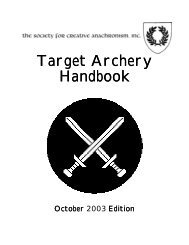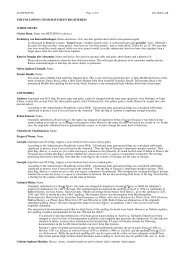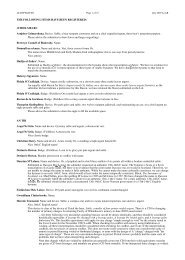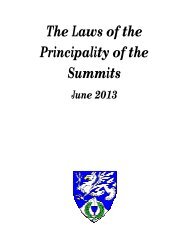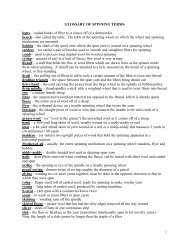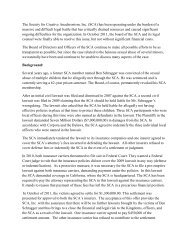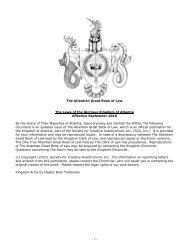The Standards for Evaluation of Names and Armory - SCA Heraldry
The Standards for Evaluation of Names and Armory - SCA Heraldry
The Standards for Evaluation of Names and Armory - SCA Heraldry
You also want an ePaper? Increase the reach of your titles
YUMPU automatically turns print PDFs into web optimized ePapers that Google loves.
<strong>The</strong> <strong>St<strong>and</strong>ards</strong> <strong>for</strong> <strong>Evaluation</strong> <strong>of</strong> <strong>Names</strong> <strong>and</strong> <strong>Armory</strong>:<strong>The</strong> Rules <strong>for</strong> SubmissionsIn the case <strong>of</strong> a saint, evidence <strong>for</strong> that saint's veneration through the naming <strong>of</strong> churches is generallyallowed. Only the <strong>for</strong>m <strong>of</strong> the name used in that culture is allowed under this allowance.For example, the Arthurian character Lancelot is found in Italian as Lancilotto. <strong>The</strong>re<strong>for</strong>e, Lancilotto,not Lancelot, is the <strong>for</strong>m allowed in Italian context. Similarly, the saint known in her lifetime asÆthelthryth was venerated by late period English people as Audrey. So Audrey is the <strong>for</strong>m allowed inlate period English context.2. Pattern <strong>of</strong> Borrowing <strong>Names</strong>: <strong>The</strong> culture must be shown to have a pattern <strong>of</strong> using name phrasesfrom that type <strong>of</strong> source. Demonstrating such a pattern requires at least two independent examples <strong>of</strong>normal people using such name phrases in the target time <strong>and</strong> place.<strong>The</strong> type <strong>of</strong> name phrase must match. Evidence <strong>of</strong> given names from a literary source does notdemonstrate the use <strong>of</strong> bynames from that source. <strong>The</strong> demonstrated pattern must also address the type<strong>of</strong> character. <strong>The</strong> use <strong>of</strong> the given names <strong>of</strong> major characters does not demonstrate the use <strong>of</strong> the givennames <strong>of</strong> minor characters. So, the pattern <strong>of</strong> using the given names <strong>of</strong> major Arthurian characters inmedieval Engl<strong>and</strong> would justify the name Bedivere even if it were not attested. It would not justify aname from the Bible or the name <strong>of</strong> a minor Arthurian character like Gwinas, who is only mentionedonce. As there is no similar pattern <strong>of</strong> borrowing in Gaelic, the Gaelic <strong>for</strong>ms <strong>of</strong> Arthurian characterscannot be registered under this allowance.Certain kinds <strong>of</strong> borrowed names were rarely used. <strong>The</strong>se will only be allowed if a pattern explicitlyincludes the use <strong>of</strong> name phrases <strong>of</strong> that type. <strong>The</strong>se include:• allegorical names (like Everyman)• the names <strong>of</strong> characters mentioned only briefly in stories• names from stories that take place in legendary time• the names <strong>of</strong> superhuman characters (including gods <strong>and</strong> monsters, but also characters thatinteract with gods or engage in superhuman acts <strong>of</strong> prowess)• the names <strong>of</strong> characters from the life stories <strong>of</strong> saints (like the parents <strong>and</strong> siblings <strong>of</strong> saints)• the names <strong>of</strong> literary placese. Legal Name Allowance: Name phrases from the submitter's legal names may be used. To do this, thesubmitter must demonstrate the name phrase on a legal document, such as a birth certificate, driver'slicense, or the like. Only the full name <strong>and</strong> the nature <strong>of</strong> the document must be visible; identificationnumbers <strong>and</strong> the like may be obscured. Official religious documents are considered evidence <strong>for</strong>religious names (Hebrew names, confirmation names), which are also allowed under this allowance.Birth names <strong>and</strong> maiden names, when documented, are also allowed under this allowance. In somecases, providing a photocopy <strong>of</strong> the document may not be possible; in such cases, a herald or heraldsmay attest that they have seen the document <strong>and</strong> this can be sufficient documentation.<strong>The</strong> name phrase must be used in precisely the way that it is spelled on the legal document. As somelegal documents obscure capitalization (by using all capitals) or omit punctuation (<strong>and</strong> markings likeaccents), such changes may be allowed on a case by case basis. Name phrases must be used in theirentirety, including any prepositions <strong>and</strong> articles. Thus, nicknames that do not appear on legaldocuments cannot be registered.For example, the legal name Ruby justifies Ruby, but not Rubie or Rube. <strong>The</strong> legal name Smith justifiesSmith, but not the Smith. This is true even though one can find occupational bynames in English bothwith <strong>and</strong> without articles. <strong>The</strong> legal name von Volvorth justifies von Volvorth, not Volvorth or deVolvorth, though one can find examples <strong>of</strong> bynames <strong>for</strong>med from German placenames using those<strong>for</strong>ms.<strong>St<strong>and</strong>ards</strong> <strong>for</strong> <strong>Evaluation</strong> <strong>of</strong> <strong>Names</strong> <strong>and</strong> <strong>Armory</strong> – April 29, 2012 - Page 10 <strong>of</strong> 73



